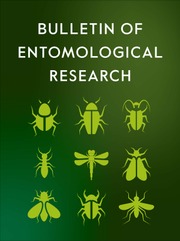No CrossRef data available.
Article contents
Level of host concealment shape parasitoid community of microlepidopteran species living on hops
Published online by Cambridge University Press: 26 August 2025
Abstract
Parasitoid–host interactions are key drivers of insect community structure, and host concealment is known to influence both parasitoid diversity and parasitism rates. However, the effectiveness of different host defence strategies in mitigating parasitism remains insufficiently understood. In this study, we examined how the level of host concealment affects parasitoid communities and parasitism rates in two microlepidopteran species living on hops (Humulus lupulus L.): Caloptilia fidella, which employs a leaf-rolling strategy, and Cosmopterix zieglerella, a strict leaf-miner. We collected a total of 774 and 150 host-infested leaves for C. fidella and C. zieglerella, respectively. Parasitism rates were calculated as the proportion of leaves from which parasitoids emerged and were averaged across three years. We combined traditional morphological identification with molecular species delimitation based on ITS2 and CO1 markers, employing ASAP (Assemble Species by Automatic Partitioning) and Bayesian Poisson Tree Processes (bPTP) methods to refine parasitoid taxonomy and detect cryptic species. Our results showed that semi-concealed C. fidella larvae in leaf rolls experienced significantly higher parasitism rates than their mining stages, while fully concealed C. zieglerella larvae exhibited generally lower parasitism. Molecular analyses confirmed idiobiont strategies in several parasitoid species, including Sympiesis acalle, S. sericeicornis, and Elachertus fenestratus, and bPTP outperformed ASAP in detecting cryptic diversity. These findings suggest that, in the studied system, leaf-mining offers more effective protection from parasitoids than leaf-rolling. Additionally, the study highlights the value of molecular tools in species delimitation and underscores their importance for improving parasitoid taxonomy and advancing our understanding of host–parasitoid dynamics.
Keywords
Information
- Type
- Research Paper
- Information
- Copyright
- © The Author(s), 2025. Published by Cambridge University Press.


